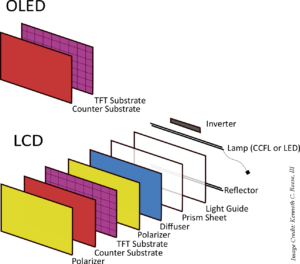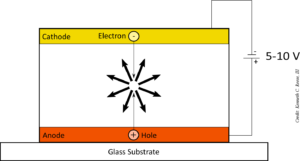Microcontrollers (MCUs) have a few display options available. A Liquid Crystal Display (LCD) is a common, low-cost option that uses a backlight made of either cold-cathode fluorescent tubes (CCFL) or light emitting Diodes (LEDs). The term “LED display” actually refers to an LCD display with LED backlighting, and thus is the same thing as an “LCD Display.” Another display option is the Organic Light-Emitting Device (OLED), which emits light in a manner similar to LEDs and therefore does not require a separate backlight. An LCD has many more components than OLED displays, and for example might include a light guide panel and a diffuser to evenly disperse the light emitted from the backlight across the whole screen, liquid crystal shutters that switch the light on and off throughout the display, polarizing film and other components to drive the LCD shutters and reflect the backlight (although manufacturing components and techniques may vary).

Many microcontrollers have built-in circuitry for display drivers so that the MCU can directly control the display or segments in a display. Controlling a display with an MCU is relatively easy if the display is a simple segment-driven (e.g., text-only), monochrome display. Several MCUs include a software library for operating LCD displays, which will be driver-specific. Find the software library that matches the hardware that drives the LCD display. Sometimes off-brand hardware display drivers will be compatible with other display drivers that are already in wide use so you can still use the software library for the compatible driver. Expect to use several pins for data and power for the backlight that should be included with a segment-driven display. According to the Arduino site, which offers LiquidCrystal software libraries, the Hitachi HD44780 driver has a 16-pin interface. Some MCUs use SPI or I2C to drive an LCD or OLED display. Small OLED displays have become fairly affordable and make sense if you have a strict power budget. See Table 1 for comparison of OLED and LCD to make the best choice for your design.
Table 1: A Comparison of OLED vs. LCD
| Parameter | OLED | LCD (CCFL or LED backlight) |
| Response Time | Extremely fast, up to 1,000 times faster than LCD (On the order of 0.01ms) | Slower. (On the order of 1ms) |
| Viewing angle | Lambertian distribution | Narrower, high contrast angle region. |
| Quantity of components | Less | More |
| Luminance reduction | Larger | Small |
| Susceptibility to Oxygen & Water | Larger | Small |
| Viewing Contrast | Deeper blacks than LCD | Only as black as the backlighting allows. |
| Thickness | Thinner than LCD/LED displays | Thicker than OLED. |
| Power Consumption | Low; no backlight to power | Must power a backlight. |
| Long-term image retention (a.k.a. Burn-in) | Burn-in is possible, but rare according to OLED maker LG. | Not likely. |
| Loss of display brightness | Improving with the maturation of the technology. Up to a 50% loss in brightness can occur over a lifespan of 10 – 50 years, depending on manufacturer and hours of use per day. | Do not lose brightness unless the (LED/CCFL) backlight fails. |
| Price | Size being the same, OLED is more expensive. Small OLED displays are somewhat affordable. | Ranges from very affordable to expensive, but a display of the same size is less expensive than OLED. |
| Viewing angle | Much wider viewing angle than LCD. (~80 degrees) | Limited to around 50-degree viewing angle. |
| Transparency | Can be made fairly transparent so that a see-through display is possible. | Backlighting precludes a transparent display. |
| Touch Screen Capability | Available | Available |
| Flexibility | Flexible, curved displays possible. Can roll an OLED display on a scroll. | Negligible
|
| Contrast | Superior, life-like | Acceptable |
A comparison of attributes
PROs: LCD displays are thicker and heavier than OLED displays and consume more power than OLEDs, due to the need for a backlight. OLEDs have self-emitting light and do not require backlights. However, OLED displays do not put out as much light as an LCD/LED display. (E.g., all things being equal, an OLED display as a flashlight is not as effective as your smartphone’s LED display screen in a dark room.) Without a backlight, OLED displays do not leak light when black areas are shown on the OLED display, unlike LCD displays. With OLED displays, each pixel that is set to black is going to be really black. OLEDs, being self-emitting light sources, are also controllable down to the pixel. LCD displays cannot control each pixel, but control in regions. OLED technology is newer than LCD and therefore more expensive, but prices are dropping as OLED technology matures. OLED has a superior viewing angle; the picture does not diminish as you view the screen to 80 degrees or more off center, whereas LCDs lose visibility at around 50 degrees.

CONs: OLED displays can lose their brightness over long-term use, but the technology is improving with time. It is also technically possible for OLEDs to suffer long-term image retention (also known as “burn-in,” an inaccurate term for OLEDs borrowed from CRTs) under extreme conditions. However, OLEDs do not use phosphor coating as CRTs did, so burn-in is not necessarily permanent. The potential for burn-in makes OLED displays used for digital signage a poor candidate, especially if the display image is extremely bright, high-contrast, and never varies (at the pixel level), or if the OLED display is not set up with some screen preservation features. LG claims that OLED TV screens come with built-in features to avoid burn-in, such as pixel-shifting an image, termed “Screen Shift” by LG, which “moves the screen slightly at regular intervals to preserve picture quality.” LG also claims that the quality of an OLED image can be preserved “by resetting the TV so it clears the pixels.”[i] Unlike CRTs, for which long-term image retention is permanent once it’s there (and monochromatic), OLED screens experience an erasable, multi-color long term image retention. Therefore, OLED “burn-in” isn’t the same kind of permanent burn-in that CRTs can experience. Long-term image retention on an OLED screen can be “erased” by playing varying content on the OLED screen for a while.[ii] DIY digital signage with a static image on an OLED display is not recommended, however. Major manufacturers like Samsung and LG offer OLED displays for digital signage but include features to avoid long-term image retention.
[i] http://www.lg.com/us/experience-tvs/oled-tv/reliability
[ii] http://televisions.reviewed.com/features/what-to-know-about-oled-screen-burn-in-problems-causes-image-retention

Leave a Reply